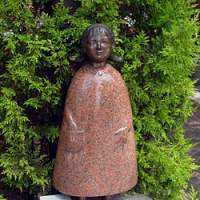Dear Alice,
I'm sending you a photo of a small statue in Azabu Juban in Tokyo. According to the sign, part of which is in English, it's of a little orphan girl who inspired a famous Japanese song called "The Girl in Red Shoes." However, my boyfriend is adamant that the sign is all wrong. He maintains that the real girl-in-red-shoes statue is in Yokohama, and that the song is actually about a young woman who was lured overseas by a bad foreign man. What's more, he insists the song is a xenophobic warning to Japanese women to stay away from gaijin men. Could you please find out what the heck's going on?
Maryanne S., Tokyo
Dear Maryanne,
I know that song — it's "Akai Kutsu no Onna no Ko," First, let me give you the lyrics. I'll offer a translation later, but I'd like you to read the Japanese so you can draw your own conclusions.
Akai kutsu haiteta onna no ko,
Ijin-san ni tsurerarete icchatta
Yokohama no hatoba kara fune ni notte,
Ijin-san ni tsurerarete icchatta
Imadewa aoi me ni nacchatte,
Ijin-san no o-kuni ni irundaro
Akai kutsu mirutabi kangaeru,
Ijin-san ni autabi kangaeru.
When I first heard this song a few years ago, I pictured a young man looking wistfully out to sea, remembering a pretty girl who married a foreigner and left Japan. This is not so different from your boyfriend's take on the song, although I didn't pick up any distrust of foreigners. But when I got your inquiry, I figured I'd better check with my friend Masae, a karaoke queen who knows all the verses of every Japanese song ever written.
Masae immediately dismissed your boyfriend's interpretation, pointing out that the word for "foreigner" (ijin, an old word in use before gaijin came along) has the honorific san on the end, which softens it and indicates respect. Besides, she harumphed, everybody knows that it's a children's song, about a little girl who is adopted by foreigners and sails from Yokohama to Europe or America.
Much as I trust Masae, I decided to dig a little deeper. I confirmed that the ditty is indeed considered a children's song, first published in 1921 in a magazine for schoolchildren. The lyrics, by a famous poet named Ujo Noguchi, were different from those in other children's songs at the time in that he used the casual language (such as icchatta) that kids really use. Since then, generations of Japanese have grown up singing the song, but it was in 1978 that the story behind it came to light.
In 1973, a newspaper in Hokkaido received a letter from a woman who claimed that the "Girl in Red Shoes" was her half-sister. The woman's mother, Kayo Iwasaki, had come from Shizuoka as part of the movement to settle Hokkaido in the early 1900s, but the farming there proved so difficult she had been unable to care for her small daughter. So at the age of 3, little Kimi had been entrusted to a friend who promised to find a home for her. Years later, Kayo met the poet Ujo Noguchi and told him about having to give up her child. She believed foreign missionaries had taken Kimi in, and that her daughter now lived overseas.
Working with these sketchy details, a television producer named Hiroshi Kikuchi set off on an investigation that took nearly five years to complete. He confirmed that the woman had indeed met Noguchi, when they worked together in an office. Later, he was able to identify the missionaries, and even traveled to the United States to interview their descendants. But there was no indication that they brought a child when they returned from Japan in 1908. Eventually, Kikuchi discovered the sad truth that Kimi died of tuberculosis in 1911 at the age of 9. She had been living in an orphanage in Azabu in Tokyo, probably because she was too ill to leave Japan with her adoptive parents.
Returning to the statues, it's hard to make a case for one being more "real" than the other. The statue your boyfriend mentioned, in Yokohama's Yamashita Park, was erected in 1979, having been planned before anyone knew that Kimi had not, in fact, sailed away. The one in Azabu Juban, pictured in this column, went up in 1989 after it was learned that Kimi died in an orphanage nearby.
But these aren't the only girl-in-red-shoes statues! There's another in Kimi's birthplace, Nihondaira in Shizuoka Prefecture. And yet another in Rutsumura, Hokkaido, where she lived for a short time with her mother.
What's more, there are plans afoot for a fifth statue, in Aomori Prefecture, at the birthplace of the friend who found a home for Kimi with the missionaries. If you ask me, that's stretching the Kimi connection a bit far.
To close, I offer the following translation for "The Girl in Red Shoes."
The little girl in red shoes,
Gone away with foreigners
On a boat from Yokohama,
Gone away with foreigners
By now her eyes must be blue,
She must be in the foreigners' country
I think of her every time I see red shoes
I think of her every time I see a foreigner.
If you want to know the tune, ask any Japanese friend to sing it for you. They'll know it, I promise. And if you go by the statue in Azabu Juban, drop a coin in the box at Kimi's feet. To date, more than 10 million yen has been collected for needy children around the world.



















With your current subscription plan you can comment on stories. However, before writing your first comment, please create a display name in the Profile section of your subscriber account page.